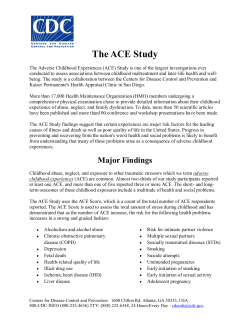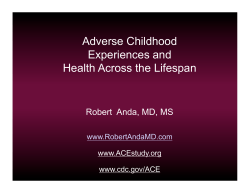
Fetal exposure to ACE inhibitors increased risk of major congenital malformations
Downloaded from ebm.bmj.com on 2 July 2009 Fetal exposure to ACE inhibitors increased risk of major congenital malformations Paul E Szmitko and David Juurlink Evid. Based Med. 2007;12;26 doi:10.1136/ebm.12.1.26 Updated information and services can be found at: http://ebm.bmj.com/cgi/content/full/12/1/26 These include: Rapid responses You can respond to this article at: http://ebm.bmj.com/cgi/eletter-submit/12/1/26 Email alerting service Topic collections Receive free email alerts when new articles cite this article - sign up in the box at the top right corner of the article Articles on similar topics can be found in the following collections Smoking and tobacco (2986 articles) Health policy (5031 articles) Epidemiologic studies (10895 articles) Genetics (1148 articles) Drugs: cardiovascular system (9868 articles) Drugs: CNS (not psychiatric) (3496 articles) Pregnancy (4139 articles) Chemotherapy (856 articles) Drugs: musculoskeletal and joint diseases (3116 Health service research (4239 articles) Diabetes (3375 articles) Health education (6714 articles) Smoking (3561 articles) Notes To order reprints of this article go to: http://journals.bmj.com/cgi/reprintform To subscribe to Evidence-Based Medicine go to: http://journals.bmj.com/subscriptions/ articles) Downloaded from ebm.bmj.com on 2 July 2009 AETIOLOGY 26 Fetal exposure to ACE inhibitors increased risk of major congenital malformations Cooper WO, Hernandez-Diaz S, Arbogast PG, et al. Major congenital malformations after first-trimester exposure to ACE inhibitors. N Engl J Med 2006;354:2443–51. Clinical impact ratings GP/FP/Primary care wwwwwwq Cardiology wwwwwwq Obstetrics wwwwwwq Paediatrics wwwwwqq Paediatric neonatology wwwwwww Paediatric hospital medicine wwwwwwq ............................................................................................................................... exposure to angiotensin converting enzyme (ACE) inhibitors during the first trimester of pregnancy associated Q Iswithfetalincreased risk of congenital malformations? METHODS and central nervous system malformations (table). The risks of any major congenital malformation and specific types were not increased in infants with exposure to other antihypertensive drugs (table). Design: database linked cohort study. CONCLUSION Fetal exposure to angiotensin converting enzyme inhibitors during the first trimester of pregnancy was associated with increased risk of congenital malformations. Setting: Tennessee, USA. Patients: 29 507 infants born between 1985 and 2000 whose mothers were enrolled in Medicaid. 209 infants had been exposed to ACE inhibitors in the first trimester only, 202 infants had been exposed to other antihypertensive drugs in the first trimester only, and 29 096 had had no such exposure. Exclusion criteria: evidence of maternal diabetes before or during pregnancy, maternal prescription for angiotensin receptor antagonists, fetal exposure to ACE inhibitors or other antihypertensive drugs beyond the first trimester, or fetal exposure to other potential teratogens. Risk factors: maternal age, race, education, previous pregnancies, urban or rural residence median neighbourhood income, late entry into prenatal care, smoking during pregnancy, year of child’s birth, and multiple pregnancy. Outcomes: major congenital malformation not related to a chromosomal defect or genetic syndrome. MAIN RESULTS The risk of any major congenital malformation was increased in infants with exposure to ACE inhibitors, particularly cardiovascular ............................................................. For correspondence: Dr W O Cooper, Vanderbilt University School of Medicine, Nashville, TN, USA. william.cooper@vanderbilt.edu Sources of funding: Food and Drug Administration; Agency for Healthcare Research and Quality; Centers for Education and Research on Therapeutics. Risk associated with prenatal exposure to angiotensin converting enzyme (ACE) inhibitors or other antihypertensive drugs in the first trimester* Relative risk (95% CI)À Outcomes ACE inhibitor Other antihypertensive drug Any congenital malformation Cardiovascular malformation Central nervous system malformation Other malformations 2.7 (1.7 to 4.3) 3.7 (1.9 to 7.3) 4.4 (1.4 to 14) 0.66 (0.25 to 1.8) 0.89 (0.22 to 3.6) ` 1.8 (0.79 to 3.9) 0.62 (0.15 to 2.5) *CI defined in glossary. Adjusted for maternal age, race, presence or absence of a chronic illness, rural or urban residence, income, year of child’s birth, and multiple birth. `No infants had this outcome. www.evidence-basedmedicine.com Commentary A CE inhibitors are contraindicated during the second and third trimesters of pregnancy because of myriad congenital abnormalities. However, their use in the first trimester has generally been considered safe, despite limited empirical evidence of safety. The study by Cooper et al examined the association between exposure to various antihypertensive agents, including ACE inhibitors, during the first trimester of pregnancy only. This elegant work, which combined elements of administrative database analysis with primary data collection, casts serious doubt on the safety of ACE inhibitors during early pregnancy. Infants born to mothers who took these drugs during the first trimester only had a nearly threefold increased risk of major congenital malformations—mostly involving the cardiovascular and neurological systems—compared with unexposed infants. No similar risk was seen with other antihypertensive medications. How should we use this information? This study provides compelling evidence that first trimester exposure to ACE inhibitors may not be as safe as previously thought. In the absence of new information, it will now be very difficult to justify prescribing ACE inhibitors at any time during pregnancy. While all drugs have side effects, many alternate antihypertensive drugs have a long track record of safety during pregnancy, including nifedipine, hydralazine, labetalol, methyldopa, and hydrochlorothiazide.1 Each has adverse effects, and the choice will depend on the patient and setting. The findings of Cooper et al should also prompt discussion with all women of reproductive age who are taking ACE inhibitors. If they are contemplating pregnancy, we believe it is advisable to switch them to another antihypertensive agent well beforehand.1 In addition, detailed fetal ultrasonography and echocardiography at around 18 weeks of gestation should be offered to women exposed to ACE inhibitors during the first trimester. The study by Cooper et al alerts us to the possibility that a drug class used by many thousands of women of childbearing age might be more teratogenic than previously appreciated. It also shows how clever approaches are sometimes necessary to study the safety of drugs in pregnancy. Finally, it underscores the need for additional studies on the safety of all antihypertensive agents in pregnancy. Birth defects caused by medications are largely preventable, but only if we have the data to do so. Paul E Szmitko, MD David Juurlink, MD, PhD, FRCPC Sunnybrook Health Sciences Centre Toronto, Ontario, Canada 1 James PR, Nelson-Piercy C. Heart 2004;90:1499–504. EBM Volume 12 February 2007
© Copyright 2025





















